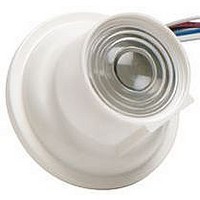DHIP HUBBELL WIRING DEVICES, DHIP Datasheet - Page 5

DHIP
Manufacturer Part Number
DHIP
Description
Daylight Harvesting Indoor Photocell
Manufacturer
HUBBELL WIRING DEVICES
Datasheet
1.HMHBSA.pdf
(28 pages)
Specifications of DHIP
Peak Reflow Compatible (260 C)
No
Leaded Process Compatible
No
For Use With
H-MOSS Motion Sensing Switches
Lead Free Status / RoHS Status
Contains lead / RoHS non-compliant
How to Select the Right Technology
for the Proper Application
Passive Infrared
(PIR)
Ultrasonic (US)
Dual Technology
Dual technology occupancy sensors combine both passive infrared (PIR) and
ultrasonic (US) technologies for maximum reliability. Because US and PIR need
to both detect occupancy to turn lighting on, dual technology sensors minimize
the risk of lights coming on when the space is unoccupied—false triggering.
Continued detection by only one technology then keeps lighting on as necessary.
Dual technology sensors offer the best performance for most applications.
Benefits:
• Track occupancy on with two sensing methods
• Minimizes false triggering
• Consistent, reliable operation
Ultrasonic (US) technology senses occupancy by bouncing sound waves (32 kHz
- 45 kHz) off of objects and detecting a frequency shift between the emitted and
reflected sound waves. Movement by a person or object within a space causes a
shift in frequency, which the sensor interprets as occupancy. While US occupancy
sensors have a limited range, they are excellent at detecting even minor motion
such as typing and filing, and they do not require an unobstructed line-of-sight.
This makes US technology sensors ideal for an application like an office with
cubicles or a restroom with stalls.
Benefits:
• Detect small motion
• Sees around obstructions
• Cost efficient
Passive infrared (PIR) technology senses occupancy by detecting the movement
of heat emitted from the human body against the background space. Unlike US
technology, PIR sensors require an unobstructed line-of-sight for detection. These
sensors use a segmented lens, which divides the coverage area into zones.
Movement between zones is then interpreted as occupancy. PIR sensors are ideal
for detecting major motion (e.g. walking), and they work best in small, enclosed
spaces with high levels of occupant movement.
Benefits:
• Long range detection
• Reliable triggering
• Cost efficient
www.hubbell-wiring.com
5













